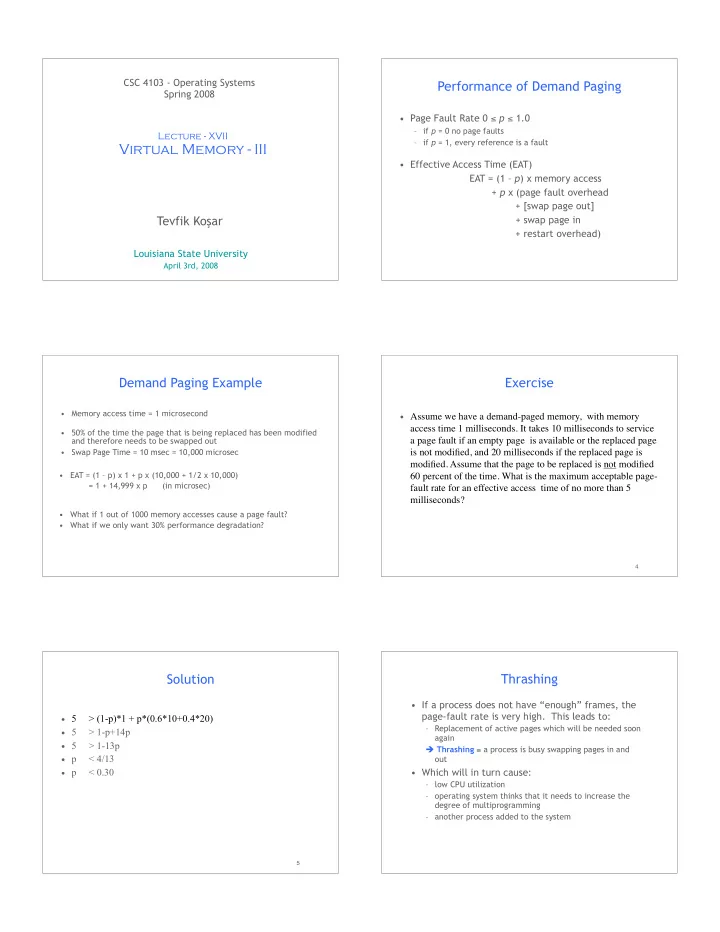

CSC 4103 - Operating Systems Performance of Demand Paging Spring 2008 • Page Fault Rate 0 � p � 1.0 – if p = 0 no page faults Lecture - XVII – if p = 1, every reference is a fault Virtual Memory - III • Effective Access Time (EAT) EAT = (1 – p ) x memory access + p x (page fault overhead + [swap page out] Tevfik Ko � ar + swap page in + restart overhead) Louisiana State University April 3rd, 2008 1 Demand Paging Example Exercise • Memory access time = 1 microsecond • Assume we have a demand-paged memory, with memory access time 1 milliseconds. It takes 10 milliseconds to service • 50% of the time the page that is being replaced has been modified and therefore needs to be swapped out a page fault if an empty page is available or the replaced page • Swap Page Time = 10 msec = 10,000 microsec is not modified, and 20 milliseconds if the replaced page is modified. Assume that the page to be replaced is not modified • EAT = (1 – p) x 1 + p x (10,000 + 1/2 x 10,000) 60 percent of the time. What is the maximum acceptable page- = 1 + 14,999 x p (in microsec) fault rate for an effective access time of no more than 5 milliseconds? • What if 1 out of 1000 memory accesses cause a page fault? • What if we only want 30% performance degradation? 4 Solution Thrashing • If a process does not have “enough” frames, the page-fault rate is very high. This leads to: • 5 > (1-p)*1 + p*(0.6*10+0.4*20) – Replacement of active pages which will be needed soon • 5 > 1-p+14p again • 5 > 1-13p � Thrashing � a process is busy swapping pages in and • p < 4/13 out • p < 0.30 • Which will in turn cause: – low CPU utilization – operating system thinks that it needs to increase the degree of multiprogramming – another process added to the system 5
Thrashing (Cont.) Page-Fault Frequency Scheme • Establish “acceptable” page-fault rate – If actual rate too low, process loses frame – If actual rate too high, process gains frame Allocation of Frames Fixed Allocation • Equal allocation – For example, if there are 100 • Each process needs minimum number of pages frames and 5 processes, give each process 20 • Example: IBM 370 – 6 pages to handle SS MOVE frames. instruction: • Proportional allocation – Allocate according to the – instruction is 6 bytes, might span 2 pages size of process – 2 pages to handle from – 2 pages to handle to • Two major allocation schemes – fixed allocation – priority allocation Priority Allocation Global vs. Local Replacement • Global replacement – process selects a • Use a proportional allocation scheme using replacement frame from the set of all priorities rather than size frames; one process can take a frame from another • If process P i generates a page fault, • Local replacement – each process selects from only its own set of allocated frames – select for replacement one of its frames – select for replacement a frame from a process with lower priority number
Acknowledgements • “Operating Systems Concepts” book and supplementary material by A. Silberschatz, P . Galvin and G. Gagne • “Operating Systems: Internals and Design Principles” book and supplementary material by W. Stallings • “Modern Operating Systems” book and supplementary material by A. Tanenbaum • R. Doursat and M. Yuksel from UNR 13
Recommend
More recommend